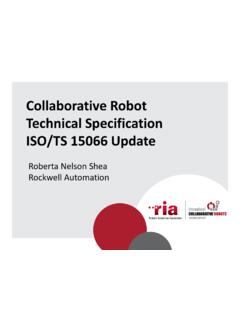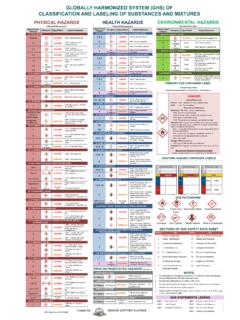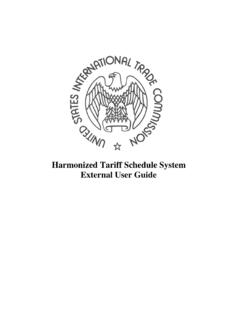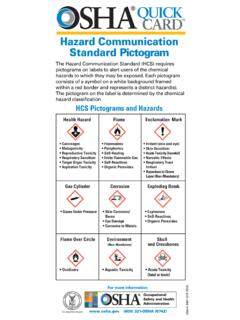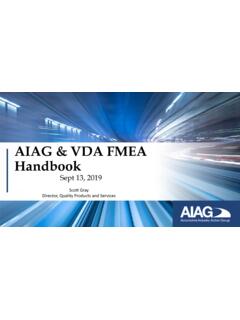Transcription of Robot Safety Standard Update - A3 Robotics
1 Robot Safety Standard Update Roberta Nelson Shea Senior Director, EHS at C&S Wholesale Grocers Director, Safety & Compliance at Symbotic LLC. February 20-22, 2013 | Orlando World Marriott Center | Orlando, Florida USA. Why standards ? standards help level the market playing field when all players meet the Standard (s). standards provide risk management assistance by helping to limit liability for products meeting Standard (s). standards help meet market demands (presuming the market demands compliance with the Standard (s)). standards lower costs by standardizing designs & mfg. Globally harmonized standards allow products to be global, rather than regional designs. Equipment can be shipped between facilities of global companies. ISO standards Framework ISO . TECHNICAL MANAGEMENT BOARD. Standardization is highly structured and organized to TC 184 TC 199. minimize overlapping scopes. Industrial Automation Safety of .. standards are supposed to use Systems & Integration Machinery the work of other standards (and not reinvent the wheel ).
2 For harmonized SC1 SC2SC3. SC3. SC3. SC3 WG5 SC3. WG6 SC3. SC3. SC3 standards (EN ISO), Physical Robots for .. Machinery Safety Distances .. CEN Consultants device industrial Design & Risk & Ergonomic (technical experts). control environment Assessment Aspects review the content to judge whether ISO 9946 Presentation of Characteristics the Standard ISO 10218-1 Safety of Robots complies with the ISO 10218-2 Safety of Robot Integration various EU. ISO 9409-1 Mechanical Interfaces .. Directives. ANSI standards Framework ANSI ANSI . standards are based on market demand .. without oversight as to technical content. Accredits an organization to be a SDO. RIA AWS NFPA B11 ( standards Development Organization) for a S S .. S .. specific market/ scope. Oversight of ANSI stds development is to its processes and the development procedures. Over 240 standards about weld Standard (s) do not have to use the materials, techniques, certification, work of other ANSI standards .
3 Safety of weld Robot systems, .. ANSI/ RIA Design of Robot Control Pendants - inactive ANSI/ RIA Performance Characteristics - inactive ANSI/ RIA Safety of Robots, + Integration of Robots, Robot Systems, Robot Cells ANSI/ RIA Robot Offline Programming - inactive RIA , , and more standards Comparison ANSI standards and Technical Reports Are voluntary unless adopted as a regulation (law). Can be adopted by OSHA (unusual) or other jurisdiction (state, county, city For example, UL 1740 has been adopted by some states and localities). Applies to one or more of the following: the manufacturer of the component ( , connectors, cable, fasteners, component machine such as a conveyor). the integrator of the component or machine. the user of the component or machine (company using the machine). Compliance can be used as a Means of complying with OSHA requirements of a safe workplace (since there are many more ANSI standards than regulations) but NOT presumption of compliance.
4 Civil legal defense for providing a safe workplace based on current practices. OSHA standards Are regulatory standards (required by law). Are NOT comprehensive. There are VERY few OSHA machine Safety standards ( , mechanical power presses, forging machines, cooperage machines). There is NO OSHA Robot Standard , however OSHA references as being the Standard applicable to Robot systems. Applies to the USER (the company that uses the machine). There can be requirements that apply to EMPLOYEES (example lock-out). standards Comparison ISO standards , Technical Specifications, & Technical Reports Are voluntary unless adopted as a regulation. Are meant to allow globalization of trade by unifying border requirements. Are often adopted by the EU as a harmonized Standard which means that the EN. ISO Standard provides a presumption of conformity (complies with Directives). Applies to SUPPLIER of the component or machine: the manufacturer of the component or machine.
5 The integrator of the component or machine (if the USER acts a the supplier, the USER is required to comply). Compliance can be used as a A LEGAL presumption of conformity with the machinery directive (if harmonized ). Civil legal defense of providing a safe workplace based on industry practices. Country Workplace Safety standards Are regulatory standards (required by law). This is same as OSHA for the USA. In Europe, each country has its own workplace Safety requirements, PLUS. Compliance with the Directives is a legal requirement, where EN standards compliance provides the means by which to meet the Directives. Suppliers have to meet the Directives for product import and sales within the EU. The USER is required to acquire & use products complying with Directives. Applies to the USER. There can be requirements that apply to EMPLOYEES.. ISO Robot Safety standards Activity ISO 10218-1 Robots & -2 Integration published in 2011. These standards are based on the 1999 1999 was torn into two parts: Robot manufacturer (-1) and requirements for systems (with end-effectors) & integrators (-2).
6 USA provided input to the ISO 10218 standards development: met between ISO meetings to review & develop input. TS (Technical Specification) 15066 is in process. It is a about collaborative robots and their use. It is a TS. because more application knowledge is needed before publishing a collaborative Robot Standard . The need of a robotic device document has been identified. Canada Robot Safety standards Activity Update to CAN CSA Z434 is expected to be published in 2013. Consists of ISO 10218-1, ISO 10218-2, Canadian deviations (additions), & User requirements interspersed throughout. There are additional addendums to aid in the use of the new Standard . CSA Z434 will contain all ISO requirements (clearly shown) as the Canadian deviations and additions. This means that Robot standards for Canada CSA, USA ANSI, ISO, and EN ISO are harmonized to be almost the same. AND. Because both the Z434 and are adoptions of ISO 10218-1. and ISO 10218-2, it is easy to compare and see differences.
7 UL 1740. UL 1740 was developed as a certification Standard for As such it has requirements that are in addition to The revision process is starting soon or in process. The HOPE is that the next revision will be harmonized with ISO/. RIA/ CSA. This could mean EITHER. Harmonize globally for robots (part 1) and accept certification (from other NRTLs) to ISO 10218 since it is the same as ANSI. RIA 2012. OR. ONLY address specific US electrical requirements ANSI / RIA Robot Safety standards Activity 2012 has been approved by RIA balloting, but is still in the ANSI review & approval process. NEW is a NATIONAL adoption of ISO 10218-1 & -2. An Update to ANSI RIA 1999. ISO 10218-1 and -2, which started using1999 as the base. ANSI RIA 2012 = ISO 10218-1 + ISO 10218-2 +. (Foreword + Introduction + Bibliography). -1: Robot arm and its controller ONLY! No end-effector Stakeholder Robot Manufacturer Equivalent to Clause 4 ONLY of 1999 -2: Industrial Robot system & integration Stakeholders Integrator, Installer, and also the User but only if/.
8 When the User acts as the designer, integrator or modifier. Equivalent to Clauses 5 & 6 of 1999 1999 -> 2012 Transition ANSI RIA 1999 can be used until the end of 2014. During this ~ 2 year transition, there is a choice of using EITHER the 1999 (R2009) or new 2012 The overlap with the 1999 (R2009) allows: A transition for on-going projects and for constituents to become comfortable with a new Standard after 13 years with 1999 The committee to publish needed accompanying documents. RIA TR a risk assessment methodology, however other methodologies are acceptable so long as the outcome is at least as stringent as the methodology. Update of the methodology in RIA TR safeguarding (w/ ISO safeguarding information). This is an Update to the materials that were included in USER requirements. Collaborative robots/ collaborative application guidance. Manual Work Stations (when is a work station a hindering device which act prevents entry to a cell).
9 Possibly a Prescribed Methodology with a risk assessment required for the application and environment (like the 1999 Prescribed Methodology). ANSI Robot Safety standards Activity Due to the NEW , the following standards and Technical Reports will be withdrawn at the end of 2014. (when the 1999 is withdrawn): ANSI RIA 1999: Robot Mfg, Integration and Use Safety . RIA TR 2006: Teaching Multiple Robots. Applicable ONLY when using the 1999 RIA TR 2008: Guidelines for Implementing ISO 10218-1. and complying with ANSI RIA 1999. Applicable ONLY when using the 1999 ANSI / RIA / ISO 10218-1: 2007. Applicable ONLY when using the 1999 Terminology Changes Robot Robot , NO end effector Robot system Robot (s) w/ end effector and any task equipment Robot cell Robot system(s). & all within safeguarded space Slow speed Reduced speed Safety stop Protective stop Teach mode* MANUAL reduced speed MODE *. * teach is a task using manual mode APV MANUAL high speed MODE.
10 Or Hi-speed APV . Terminology Monitored standstill function (Part 1, ). = Stop Cat 2 per NFPA79 (IEC 60204). Power is ON and motion is monitored to be standstill . Equivalent to Drive STO (Safe-Torque-Off of drives). Operator = ALL PERSONNEL, not simply production personnel (see RIA Introduction). ( Safety -rated) Terminology Additions Safety -rated Definition in Part 1, : characterized by having a prescribed Safety function with a specified Safety -related performance. Safety -rated monitored speed ( ). Safety -rated reduced speed ( ). Safety -rated soft axis and space limiting ( ). Safety -rated soft limit ( ). Safety -rated output ( ). Safety -rated zone output ( ). Safety -rated monitored stop ( ). These Safety -rated features are optional, the Standard states the requirements WHEN/ IF the feature is provided. (Collaborative) Terminology Additions Collaborative Part 1, & Part 2, Collaborative Robot , Definition: Part 1, & Part 2, Robot designed for direct interaction with a human within a defined collaborative workspace ( ).


